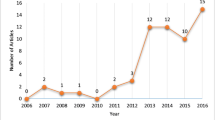Abstract
Among the emerging technologies that have been best received in education so far in the first quarter of the twenty-first century, Augmented Reality has been widely positioned. Despite its popularity, the characteristics of its influence and application are unknown in detail. This study focused on the context of Augmented Reality in education. Based on the PRISMA methodology, a systematic mapping was carried out from 70 articles published in the Scopus and Web of Science databases between the years 2011–2021. It was identified that: there is a preference for empirical studies; Spain has the highest scientific production; the studies were mostly directed at university students; and that virtual reality, education, educational technology, entrepreneurship and innovation are the main topics addressed. It is interpreted that there are opportunities in terms of: (1) Studies with mixed methodology; (2) Application in non-university population; and (3) Integration of Augmented Reality in the curriculum. Finally, it is deduced that the economic impulse of local organizations could support the geographic decentralization of Augmented Reality.
Access this chapter
Tax calculation will be finalised at checkout
Purchases are for personal use only
Similar content being viewed by others
References
ONU: Objetivos y metas de desarrollo sostenible [Sustainable development goals and targets]. https://www.un.org/sustainabledevelopment/es/objetivos-de-desarrollo-sostenible/. Last accessed 28 July 2023
UNESCO: Objetivos de Desarrollo Sostenible - Educación de Calidad [Sustainable Development Goals - Quality Education]. https://www.unesco.org/es/education/education2030-sdg4. Last accessed 28 July 2023
Kirimi, K.J.: Impact of information communication technology on education-Kenya. J. Educ. Soc. Res. 4(1) (2014)
Cabero Almenara, J., Fernández Robles, B.: Las tecnologías digitales emergentes entran en la Universidad: RA y RV [Emerging digital technologies enter the University: AR and VR]. RIED. Revista Iberoamericana de Educación a Distancia 21(2), 119 (2018)
Santos Baranda, J., Armas Velasco, C.: La integración de las tecnologías para el aprendizaje y el conocimiento (tac) en los procesos formativos universitarios [The integration of technologies for learning and knowledge (tac) in university training processes]. Investigación en Educación Médica 8(31), 72–81 (2019)
Tecnológico de Monterrey: Realidad aumentada y virtual [Augmented and virtual reality]. https://observatorio.tec.mx/edu-reads/edu-trends-realidad-virtual-y-realidad-aumentada/. Last accessed 28 July 2023
Milgram, P., Kishino, F.: A taxonomy of mixed reality visual displays. IEICE Trans. Inf. Syst. E77-D(12) (2011)
Cañellas Mayor, A.: Apuntes docentes posibilidades educativas de la realidad virtual inmersiva [Teaching notes: Educational possibilities of immersive virtual reality]. http://www.centrocp.com/apuntes-docentes-posibilidades-educativas-la-realidad-virtual-inmersiva/. Last accessed 28 July 2023
Azuma, R.: A survey of augmented reality. Found. Trends Human-Comput. Interact. 8(2–3), 73–272 (2014)
Tecnológico de Monterrey: Radar de Innovación Educativa de Preparatoria 2016 [High School Educational Innovation Radar 2016]. https://observatorio.tec.mx/edu-reads/radar-de-innovacion-educativa-de-preparatoria-2016/. Last accessed 28 July 2023
Azuma, R.T.: The road to ubiquitous consumer augmented reality systems. Human Behavior Emerg. Technol. 1(1), 26–32 (2019)
Prendes Espinosa, C.: Realidad aumentada y educación: análisis de experiencias practices [Augmented reality and education: analysis of practical experiences]. Píxel-Bit, Revista de Medios y Educación 46(46), 187–203 (2015)
Statista: Percentage of cell phone users over the population in Mexico from 2015 to 2021. https://www.statista.com/statistics/731346/number-of-mobile-phone-users-mexico/. Last accessed 28 July 2023
García-Peñalvo, F.J.: SLR, mappings y meta-análisis, Recursos docentes de la asignatura Procesos y Métodos de Modelado para la Ingeniería Web y Web Semántica [SLR, mappings and meta-analysis, teaching resources for the subject Processes and Modeling Methods for Web Engineering and Semantic Web]. https://repositorio.grial.eu/handle/grial/2244. Last accessed 28 July 2023
García-Peñalvo, F.J.: Desarrollo de estados de la cuestión robustos: Revisiones Sistemáticas de Literatura [Developing Robust Statements of Matter: Systematic Literature Reviews]. Educ. Knowl. Soc. 23, e28600 (2022)
Kitchenham, B., et al.: Systematic literature reviews in software engineering—a tertiary study. Inf. Softw. Technol. 52(8), 792–805 (2010)
García-González, A., Ramírez-Montoya, M.-S.: Systematic mapping of scientific production on open innovation (2015–2018): opportunities for sustainable training. Sustainability 11(6), 1781 (2019)
Kroll, J., Richardson, I., Prikladnicki, R., Audy, J.L.N.: Empirical evidence in follow the sun software development: a systematic mapping study. Inf. Softw. Technol. 93, 30–44 (2018)
PRISMA: The PRISMA 2020 statement: an updated guideline for reporting systematic reviews. https://www.bmj.com/content/372/bmj.n71. Last accessed 28 July 2023
Hernandez-Sampieri, R., Mendoza, C.: Metodología de la Investigación: Las rutas cuantitativa, cualitativa y mixta [Research Methodology: Quantitative, qualitative and mixed routes]. http://www.biblioteca.cij.gob.mx/Archivos/Materiales_de_consulta/Drogas_de_Abuso/Articulos/SampieriLasRutas.pdf. Last accessed 28 July 2023
Marín-Díaz, V., Cabero-Almenara, J., Gallego-Pérez, O.M.: Motivation and augmented reality: students as consumers and producers of learning objects. Aula Abierta 47(3), 337–346 (2018)
Cabero Almenara, J., Barroso Osuna, J.: Ecosistema de aprendizaje con “realidad aumentada”: posibilidades educativas [Learning ecosystem with “augmented reality”: educational possibilities]. Revista Tecnología, Ciencia y Educación 5, 141–154 (2016)
Cabero Almenara, J., Ruiz Palmero, J.: Las Tecnologías de la Información y Comunicación para la inclusión: reformulando la brecha digital [Information and Communication Technologies for inclusion: reformulating the digital divide]. IJERI: Int. J. Educ. Res. Innov. 0(9), 16–30 (2017)
Martínez Pérez, S., Fernández Robles, B.: Objects ofaugmented reality: perceptions of pedagogy students. Pixel-Bit, Revista de Medios y Educacion 53, 207–220 (2018)
Acknowledgements
The authors acknowledge the financial support of Tecnologico de Monterrey through the “Challenge-Based Research Funding Program 2022”. Project ID # I004-IFE001-C2-T3-T, and the Grants for Scientific Papers Publication (FAP).
Author information
Authors and Affiliations
Corresponding author
Editor information
Editors and Affiliations
Rights and permissions
Copyright information
© 2024 The Author(s), under exclusive license to Springer Nature Singapore Pte Ltd.
About this paper
Cite this paper
Velarde-Camaqui, D., Sanabria-Z, J., Ramírez-Montoya, M.S., Cebral-Loureda, M. (2024). Augmented Reality in Educational Innovation: A Literature Mapping Review. In: Ibáñez, D.B., Castro, L.M., Espinosa, A., Puentes-Rivera, I., López-López, P.C. (eds) Communication and Applied Technologies. ICOMTA 2023. Smart Innovation, Systems and Technologies, vol 375. Springer, Singapore. https://doi.org/10.1007/978-981-99-7210-4_5
Download citation
DOI: https://doi.org/10.1007/978-981-99-7210-4_5
Published:
Publisher Name: Springer, Singapore
Print ISBN: 978-981-99-7753-6
Online ISBN: 978-981-99-7210-4
eBook Packages: Intelligent Technologies and RoboticsIntelligent Technologies and Robotics (R0)




